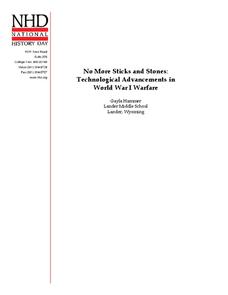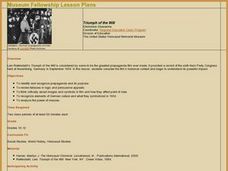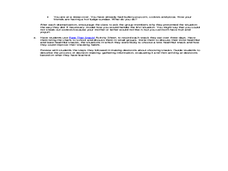Curated OER
Square Pegs in Round Holes
Sixth graders problem solve the square peg in the round whole problem by applying knowledge of the formulas for the areas of the circle and the square. They decide on a problem solving strategy based on logical reasoning.
Curated OER
Robots
Fourth graders devise and use problem solving strategies to explore situations mathematically (guess and check, make a drawing, use equipment). The use of logical reasoning is a focus of this lesson.
Education Development Center
Language of Algebra
Don't rush into algebra, let learners visualize, guess, and predict their way to a successful math career. The introductory unit incorporates beginner algebraic concepts with shapes instead of variables. Young mathematicians use a...
Radford University
Parallel Lines, Transversals, and Angles: What’s the Connection?
Streets, bridges, and intersections, oh my! Parallel lines and transversals are a present in the world around us. Learners begin by discovering the relationship of the angles formed by parallel lines and a transversal. They then apply...
Skyscraper Museum
Changes in a City Over Time
Investigate the growth and development of New York City with the final lesson in this four-part series on skyscrapers. Learners first explore the concept of urban growth by looking closely at a series of three paintings made of Wall...
Computer Science Unplugged
Battleships—Searching Algorithms
How does a computer perform a search in order to find data? The lesson begins with a demonstration on finding one number out of 15. Pairs then play three games of Battleship by using different search techniques. The lesson plan finishes...
Computer Science Unplugged
Tablets of Stone—Network Communication Protocols
Show your learners that the game of Telephone isn't the only way messages get mixed up. Pairs transform into the sender and receiver of a message sent in packets. At least one pupil is the messenger who either delivers, delays, or fails...
Worksheet Web
Language – Debating
Having a debate doesn't mean you're fighting. Introduce middle schoolers to debate with a resource which distinguishes between an quarrel and a debate, describes the debate process and format, and presents some possible debate topics.
National Science Teachers Association
Paper Car Crash Design
High school physical scientists collide with motion. They work in pairs to design a paper car that will protect a raw egg during a head-on collision. Measurements of distance traveled, time of run, vehicle specs, and photo gate flags are...
Center for Mathematics and Technology
Whole Numbers: Using an Area Model to Explain Multiplication
There are many ways to work through a multiplication problem. Using an area model, kids complete several worksheets with different types of multiplication problems, including multiplying by ten, and explain how the new strategies differ...
Bowland
Alien Invasion
Win the war of the worlds! Scholars solve a variety of problems related to an alien invasion. They determine where spaceships have landed on a coordinate map, devise a plan to avoid the aliens, observe the aliens, and break a code to...
Curated OER
Uniform Design
Learners investigate the military by examining their uniforms. In this design lesson, students analyze the military uniforms from different locations and time periods. Learners create new ideas for current military uniforms.
PBS
Stories of Painkiller Addiction: Learning About Opioids
Feeling high is not the only side effect of abusing prescription opioids. Middle and high schoolers learn more about specific painkillers, including Fentanyl, Oxycodone, and Clonazepam, as well as their common brand names and extensive...
National History Day
No More Sticks and Stones: Technological Advancements in World War I Warfare
Remind young historians that many technological advancements influenced the events of World War I. After analyzing technology's evolution through primary sources, discussing the changes over time, and watching various video clips,...
Virginia Department of Education
Metals, Nonmetals, and Metalloids
How can one easily classify metals, nonmetals, and metalloids? Pupils answer this question as they experiment with unknown substances and perform tests on conductivity, brittleness, and malleability to determine which unknown belongs in...
Virginia Department of Education
The Particle Theory of Matter
Demonstrate the particle theory of matter to high school scientists with an engaging experiment that allows them to visually see the results as substances change from one state to another. The class concludes with a discussion about how...
Curated OER
Multiplication Algorithm (1)
Third graders in a 3rd grade math class make connections from prior instruction and mastery to solve problems in new learning situations. Using logical thinking and prior knowledge to solve current math problems is the focus of this...
Curated OER
Four Color Map
Learners explore geometry by completing a color puzzle. In this shape identification lesson, students utilize deductive reasoning to complete a Google SketchUp puzzle with trapezoid, triangles and rectangular shapes. Learners complete...
Curated OER
Is This a House for Hermit Crab?
First graders identify text that uses sequence or other logical order. They identify and interpret how different plants and animals inhabit different kinds of environments and have external features that help them thrive in different...
Curated OER
Triumph of the Will
Students view the propaganda film, "Triumph of the Will". Identifying propaganda techniques used, they review any fallacies in logic or persuasive appeals. They discover elements in German culture and their meaning in 1934. They...
Curated OER
Freethinkers Day
In this Freethinkers Day worksheet, learners complete activities such as reading a passage, phrase matching, fill in the blanks, correct words, multiple choice, spelling, sequencing, scrambled sentences, writing questions, survey, and...
Curated OER
Powerful Patterns
Students use logical thinking to create, identify, extend and translate patterns. For this pattern lesson, students make patterns with objects, numbers, and shapes. Students extend and translate these patterns in several modalities...
Curated OER
How Do You Choose Snacks and Other Foods?
Young scholars discuss peer pressure pertaining to healthy eating decisions. In this personal health lesson, students identify reasons why they make poor eating decisions and how to ignore food temptations. Young scholars complete the...
Curated OER
What is Framing?
Middle schoolers practice framing issues. In this writing skills instructional activity, students participate in a classroom activity that requires them to look at specific topical issues by framing them. Middle schoolers then create...

























